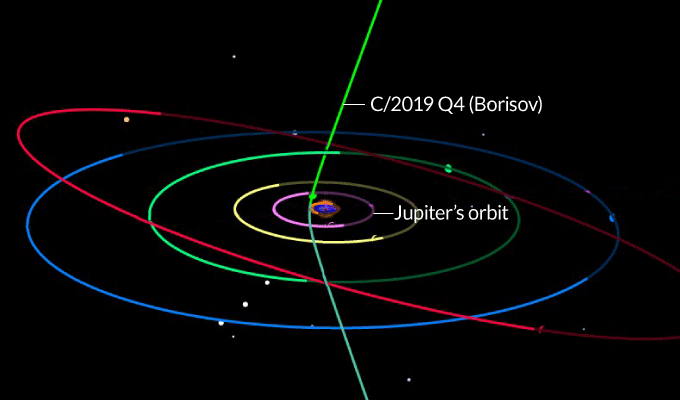Astronomers have spotted a second interstellar object – Science News
An object that seems to be a comet from around another star is speeding through the solar system. This comet, dubbed C/2019 Q4 (Borisov), marks the second time that astronomers have seen an interstellar visitor on its way past the sun.
Ukrainian amateur astronomer Gennady Borisov spotted the comet on August 30. In the days that followed, other astronomers took enough observations of the comet to show that its orbit is not bound to the sun, a telltale sign that the object is from interstellar space, says astrophysicist Matthew Holman. He is the interim director of the International Astronomical Union’s Minor Planet Center in Cambridge, Mass., which reported C/2019 Q4’s trajectory September 11 in a public bulletin.
“There have been three or four different groups that have checked the orbit and poked at it from different directions, and everybody reaches the same conclusion,” Holman says. But he cautions that the comet is close to the sun and low on the horizon, which make it difficult to observe.
“This is an unusual thing. You always want to be extra careful when you get an answer that’s not typical,” he says. “That said, I think it will hold up.”
The first known interstellar object, named ‘Oumuamua, was spotted in October 2017 as it sped away from the solar system (SN: 10/27/17). Astronomers could only grab fleeting glimpses of ‘Oumuamua on its way out the door. That left many theories for what the object was — an asteroid, a fluffy ice fractal, a skeleton of a comet, even an alien spaceship. But little data existed to back up any of those ideas (SN: 2/27/19).

C/2019 Q4, on the other hand, is just past the solar system’s doorstep, on a trajectory that will take it between the orbits of Jupiter and Mars. It will make its closest approach to Earth (at about twice the distance between Earth and the sun) on December 29.
“It’s going to be a nice Christmas comet,” says astronomer Michele Bannister of Queen’s University Belfast in Northern Ireland. The object will remain in view for several months after that.
In total, “we’ll be able to observe it for probably a year, which is really different from ‘Oumuamua,” Holman says. ‘Oumuamua was tracked for a short 2.5 months before it became too faint to see.
Already, C/2019 Q4 looks different from its predecessor. ‘Oumuamua resembled an asteroid more than a comet, with no obvious cloud of gases. C/2019 Q4 is surrounded by a bright cometlike halo, indicating that it’s sloughing off gas and dust.
That cometlike appearance is more like what astronomers expected from the first interstellar object than ‘Oumuamua was, Bannister says. Comets are a type of leftover planetary building block, called planetesimals, and most planetesimals form far from their stars and are therefore icy. Most stars end up losing their small planetesimals, either while planets are forming or after the star dies. “Almost all the planetesimals that each planetary system makes end up being scattered out to go wander the galaxy,” Banister says.
Further observations will reveal more about C/2019 Q4’s orbit, size and origin. Astronomers will also be able to tease out the comet’s composition and see how different it is from our solar system’s comets.







